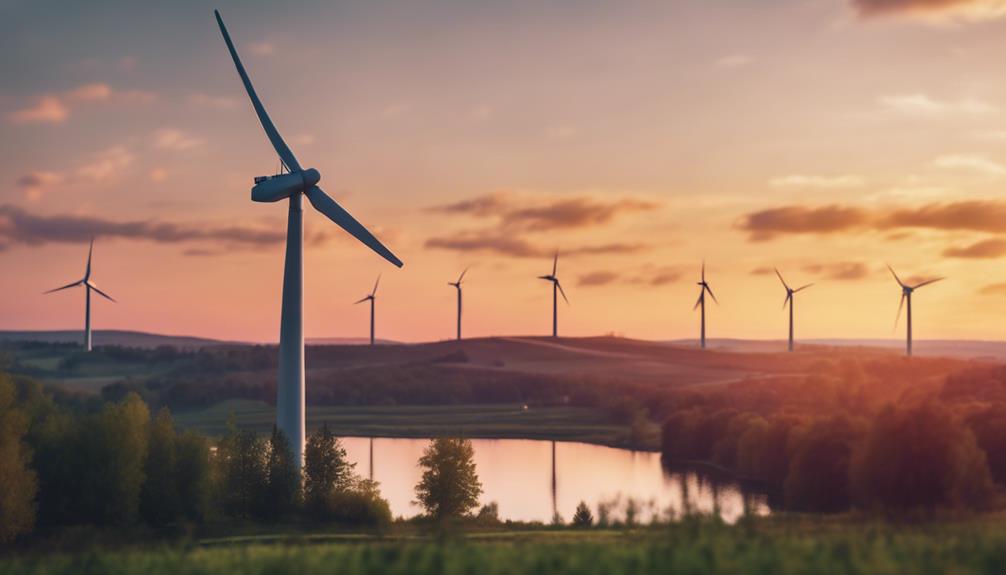One false belief about geothermal energy is that it is a major electricity producer in the US. Although it is sustainable and clean, it is not the primary source of power in the country. While geothermal plants have minimal emissions, they can present hazards like land subsidence if not managed properly. Understanding the correct information about geothermal energy is essential for harnessing its benefits efficiently.
Key Takeaways
- Geothermal power plants are the primary source of electricity in the US.
- Geothermal energy has significant environmental impacts like emissions.
- Geothermal power plants do not pose risks like land subsidence.
- Geothermal energy contributes heavily to greenhouse gas emissions.
- Geothermal energy production does not require proper management to minimize risks.
Geothermal Energy Overview
Geothermal energy, harnessed from the Earth's core, is a sustainable and renewable resource that provides electricity and heating. Unlike fossil fuels, geothermal energy taps into the natural heat stored beneath the Earth's surface, making it a clean energy alternative.
Geothermal power plants, typically located in regions with high underground heat levels like Iceland, convert this heat into electricity by driving turbines with steam or hot water.
One significant advantage of geothermal energy is its reliability. Unlike wind and solar power, geothermal energy production isn't dependent on weather conditions. This means that geothermal power plants can operate consistently, providing a stable source of electricity and heating.
Additionally, geothermal energy is considered environmentally friendly, producing minimal greenhouse gas emissions compared to traditional fossil fuel power plants.
Despite its benefits, geothermal energy does come with some environmental risks. There's a possibility of releasing harmful gases and contaminating water sources during the extraction process. However, with proper management and technology, these risks can be minimized to guarantee sustainable energy production from geothermal sources.
Common Misconceptions

Amidst various misconceptions surrounding energy sources, there are common misunderstandings about geothermal energy that need clarification. One prevalent misconception is that geothermal power plants are the primary source of electricity in the United States, which is false. While geothermal energy is a renewable resource that taps into the Earth's heat, it only contributes a small percentage to the nation's electricity generation.
Another misconception is that geothermal energy production contributes to greenhouse gas emissions, when in fact, it's a clean energy source with minimal environmental impact regarding emissions.
It is also important to note that geothermal power plants can pose environmental hazards such as land subsidence and water contamination. These risks are inherent in the operation of geothermal energy facilities and must be managed effectively.
Environmental Impact Analysis
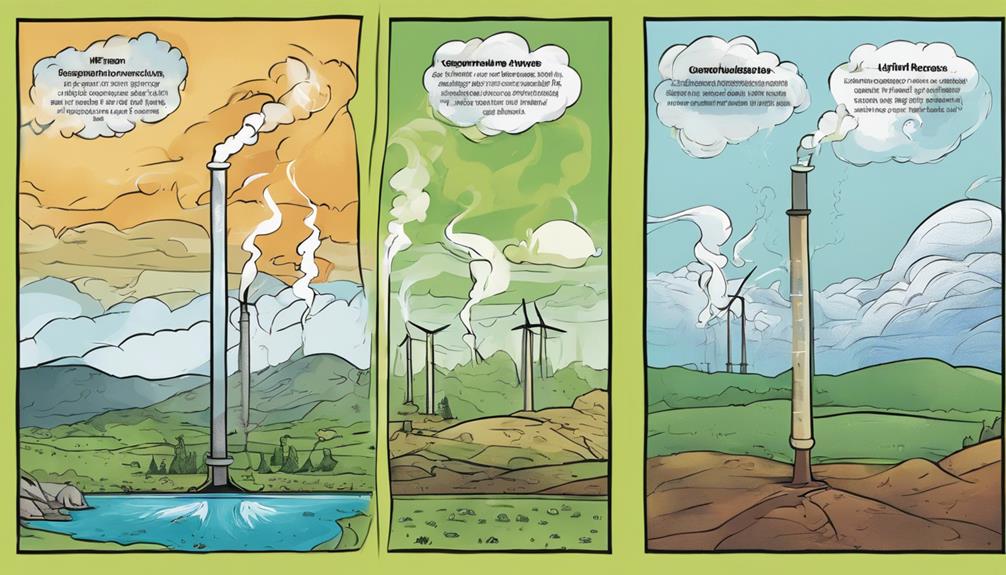
When evaluating the environmental impact of geothermal energy production, it's essential to take into account factors such as induced seismicity and subsidence that can pose significant risks. Here are some key environmental impacts to ponder:
- Release of Greenhouse Gases and Toxic Materials:
During the extraction and conversion processes of geothermal energy, there's a potential for the release of greenhouse gases and toxic substances, contributing to air and soil pollution.
- Disruption of Local Ecosystems:
Geothermal energy operations can disrupt local ecosystems and habitats, leading to the loss of biodiversity and changes in wildlife populations.
- Water Usage and Contamination:
The extraction of geothermal energy requires significant water usage, which can lead to water scarcity in certain regions. Furthermore, there's a risk of water contamination from the chemicals used in the extraction process.
- Need for Proper Management and Monitoring:
To minimize negative environmental impacts, it's vital to implement proper management practices and continuous monitoring of geothermal energy projects to ensure sustainable operations.
Key Geothermal Facts
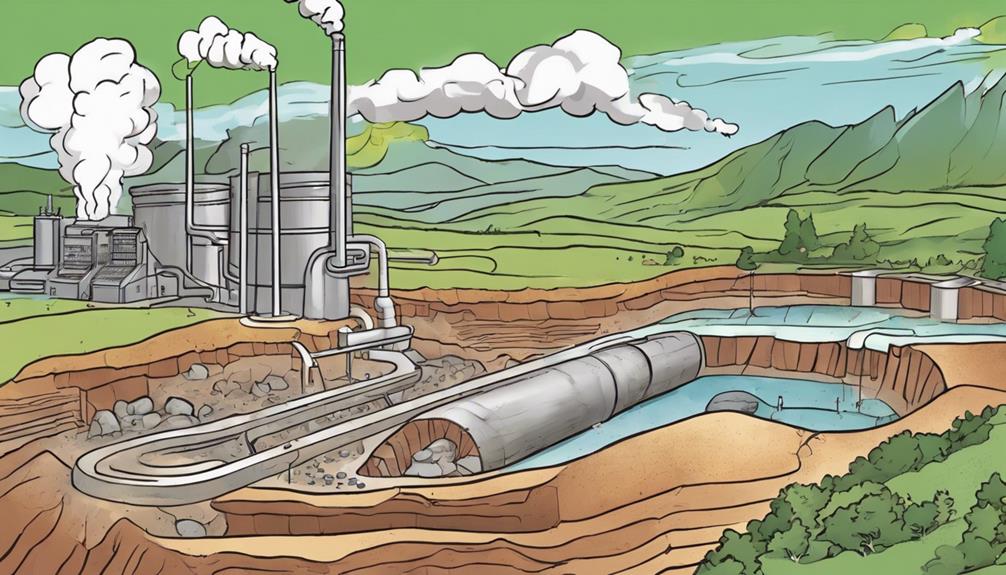
Let's address some important geothermal facts to shed light on this efficient energy source.
Geothermal energy taps into the Earth's natural heat, offering a reliable and sustainable power option.
Understanding the benefits and potential environmental impacts of geothermal power is essential for promoting responsible energy usage.
Geothermal Energy Misconceptions
Despite common misconceptions, geothermal energy is a reliable and renewable resource that harnesses heat from the Earth's core.
While there are several myths surrounding geothermal energy, understanding the key facts can help clarify any misunderstandings:
- Geothermal energy isn't the largest producer of electricity in the United States, but it does play a significant role in the renewable energy sector.
- The leading producer of geothermal electricity globally isn't the United States, showcasing the international reach and potential of this energy source.
- Environmental hazards associated with geothermal energy, such as potential seismic activity and land subsidence, are manageable with proper planning and monitoring.
- Geothermal energy offers a reliable and consistent source of power compared to wind and solar energy, making it a valuable addition to the renewable energy mix.
Benefits of Geothermal Power
How can geothermal power provide a reliable and consistent source of energy compared to other renewable options?
Geothermal power stands out for its reliability and consistency when contrasted with wind and solar energy. Geothermal power plants offer the advantage of delivering baseload power, ensuring operations 24/7 irrespective of weather conditions. Despite the challenges of high initial expenses for exploration and drilling, as well as the potential for seismic activity in specific regions, geothermal energy remains a promising renewable option.
An important aspect to take into account is that the success of geothermal power plants hinges on their geographical location, as access to hot underground reservoirs is crucial for efficient heat extraction.
Moreover, while geothermal power does release small amounts of greenhouse gases, proper management is essential to mitigate the risk of water contamination. These factors underscore the importance of geothermal power as a sustainable and dependable energy source.
Environmental Impact Analysis
Geothermal energy, as a renewable resource, harnesses heat from the Earth's interior, offering a lower environmental impact compared to traditional energy sources.
When analyzing the environmental impact of geothermal energy, it's important to take into account several key aspects:
- Seismic Activity: Geothermal power plants have the potential to induce seismic activity, which can be a concern in certain circumstances, requiring careful monitoring and evaluation.
- Greenhouse Gas Emissions: While geothermal energy is cleaner than fossil fuel-based sources, its production may still release small amounts of greenhouse gases and other pollutants into the atmosphere, albeit at lower levels.
- Environmental Management: Proper management and monitoring of geothermal sites are vital to mitigate any potential environmental risks associated with geothermal energy production.
- Sustainability: Ensuring the sustainability of geothermal energy involves implementing effective environmental practices to minimize any adverse effects on the ecosystem and surrounding areas.
Expert-Verified Information

Experts confirm that geothermal energy is a reliable and sustainable source of power with significant considerations for environmental impact. Geothermal energy, as a renewable resource, plays a vital role in providing sustainable power. Compared to wind and solar energy, geothermal energy stands out as a dependable source of power.
While geothermal energy isn't the largest producer in the US, understanding the correct statement about its production is crucial for its advancement.
Considering the environmental hazards associated with geothermal energy is essential. Despite its numerous benefits, such as low carbon emissions and continuous availability, geothermal energy production can have environmental implications that need to be carefully managed.
Experts emphasize the importance of proper environmental impact analysis and mitigation strategies when harnessing geothermal power to ensure sustainable and responsible energy production practices. By addressing these considerations, geothermal energy can continue to be a valuable and environmentally friendly source of power for the future.
False Statements Clarified
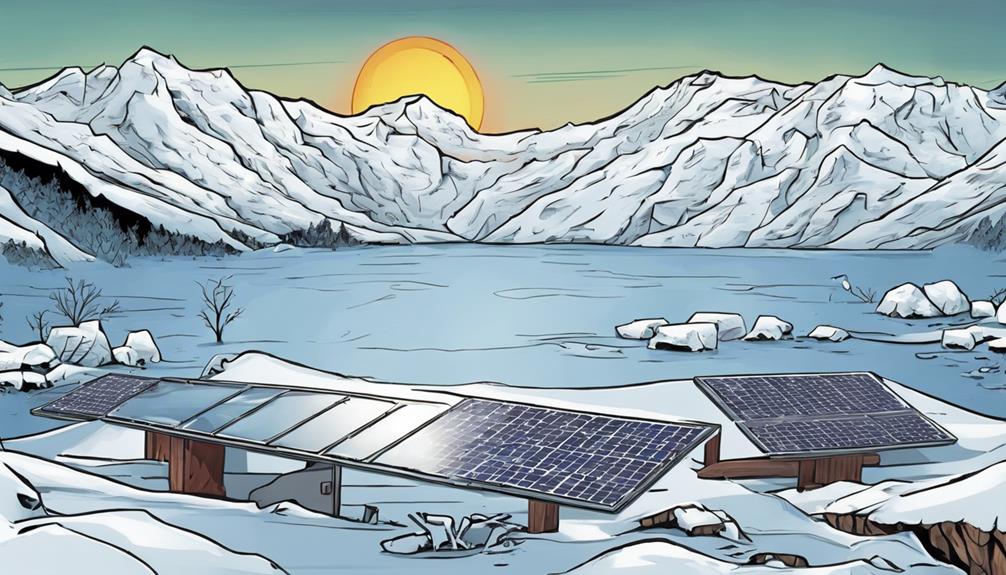
To clarify misconceptions about geothermal energy, it's important to address false statements and provide accurate information on its production and environmental implications. Here are some key points to help dispel any misinformation:
- The United States isn't the world's largest producer of geothermal energy: While the U.S. is a significant producer, countries like the Philippines and Indonesia surpass it in geothermal energy generation.
- Geothermal energy is a renewable resource that harnesses heat from the Earth's core: Unlike fossil fuels, geothermal energy derives power from the Earth's natural heat, making it a sustainable and eco-friendly energy source.
- Geothermal power plants can have environmental hazards: While geothermal energy is clean, plants can cause land subsidence and emit gases like hydrogen sulfide, impacting local ecosystems.
- Geothermal energy is reliable compared to wind and solar power: Due to its constant heat source, geothermal energy provides a stable and consistent power supply, making it a dependable alternative to more intermittent renewable sources.
Geothermal Energy Myths

You may have come across misconceptions about geothermal energy, but it's time to set the record straight.
Common myths surrounding geothermal energy need debunking to highlight its true potential.
Let's explore the truth behind these misconceptions together.
Geothermal Energy Misconceptions
Despite common misconceptions, there are several myths surrounding geothermal energy that need to be debunked. Let's clear up some of these misunderstandings:
- Geothermal energy is often mistakenly believed to be the largest source of electricity in the United States: While geothermal energy is a valuable renewable resource, it currently accounts for a small percentage of electricity generation compared to other sources like natural gas and coal.
- Some misconceptions suggest that geothermal energy isn't a renewable resource: In reality, geothermal energy is renewable as it utilizes heat from the Earth's core, which is continuously produced.
- People may falsely assume that geothermal energy poses significant environmental hazards: Contrary to this belief, geothermal energy is relatively clean and has a lower environmental impact compared to fossil fuels.
- Contrary to popular belief, geothermal energy doesn't solely rely on volcanic regions for its effectiveness: While volcanic regions are ideal for geothermal energy production, technology advancements have allowed geothermal plants to be built in non-volcanic areas as well.
Common Geothermal Energy Myths
Many myths exist surrounding geothermal energy that need clarification. One common misconception is that geothermal energy is the world's largest producer of electricity, which is false. While geothermal energy isn't the biggest producer, it's a reliable and consistent source of renewable energy.
Another myth is that geothermal power plants have a significant environmental impact like fossil fuel plants, but in reality, they've minimal environmental repercussions. Geothermal energy harnesses the Earth's heat from the crust for power generation, which is a sustainable and eco-friendly process.
Additionally, unlike wind and solar power, geothermal energy isn't limited by weather conditions, making it a dependable energy source regardless of the weather outside. By dispelling these myths, it becomes evident that geothermal energy is a viable and sustainable option for meeting our energy needs.
Debunking Geothermal Energy Myths
Contrary to popular belief, geothermal energy isn't the largest producer of electricity in the US. Here are some common myths about geothermal energy debunked:
- Myth: Geothermal energy doesn't produce carbon dioxide emissions.
- While geothermal energy is a cleaner energy source compared to fossil fuels, there are still some carbon dioxide emissions associated with the construction and maintenance of geothermal power plants.
- Myth: Geothermal energy can be easily harnessed anywhere.
- Geothermal power plants must be strategically located near geologically active areas to ensure the best energy production, limiting the feasible locations for these plants.
- Myth: Geothermal energy is completely environmentally friendly.
- Although geothermal power plants have lower environmental impacts than fossil fuel plants, they still have some environmental effects, such as the potential for induced seismicity.
- Myth: Geothermal energy is cheap and easy to implement.
- One of the challenges of geothermal energy is the high upfront costs associated with drilling and setting up geothermal plants, making it less accessible than some other renewable energy sources.
AI-Generated Answers
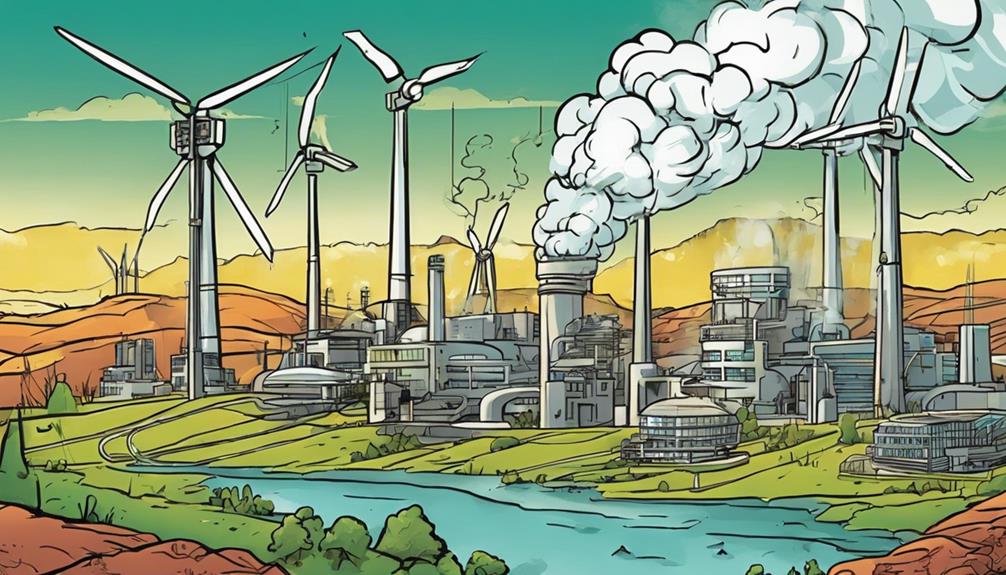
AI-generated responses swiftly address user inquiries using algorithms to offer immediate information and solutions. These automated replies are a valuable tool in enhancing user experience, guaranteeing that individuals receive timely and precise answers to their queries. By harnessing the power of AI, platforms can provide effective solutions to common inquiries, including those related to energy sources like geothermal energy.
To demonstrate the efficacy of AI-generated responses, consider the following comparison table:
| Traditional Response | AI-Generated Response |
|---|---|
| May involve delays | Provides instantaneous answers |
| Manual processing | Automated algorithmic-based responses |
| Human errors possible | Consistent and precise information |
| Limited scalability | Can manage large volumes of queries efficiently |
Through the use of AI-generated responses, platforms can make certain that users receive the information they require promptly and without errors, ultimately enhancing overall user satisfaction.
Free Expert Insights
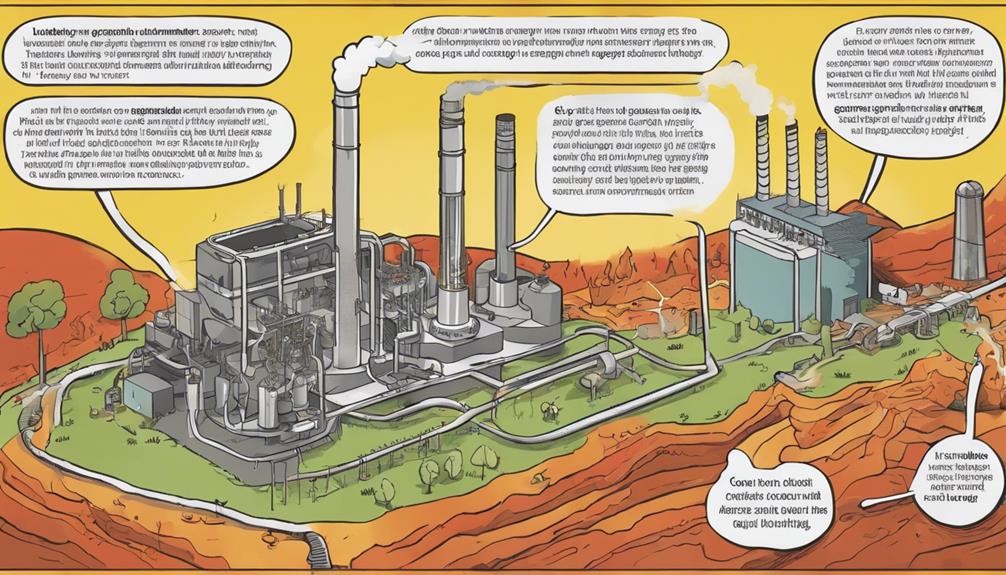
Let's clear up some misconceptions about geothermal energy, analyze its environmental impact, and assess its status as a renewable resource.
Understanding these key points will help you grasp the importance and potential of geothermal energy as a sustainable power source.
Stay tuned for valuable insights on maximizing the benefits of geothermal energy while mitigating its environmental risks.
Geothermal Energy Misconceptions
Many people mistakenly believe that the US is the leading global producer of geothermal energy, but in reality, this isn't the case. Here are some key misconceptions about geothermal energy:
- Geothermal Energy Production: Contrary to popular belief, the United States doesn't hold the top spot in global geothermal energy production. Countries like the Philippines, Indonesia, and Turkey are among the leaders in harnessing this renewable energy source efficiently.
- Reliability and Sustainability: Geothermal energy is often underestimated when it comes to reliability and sustainability compared to wind and solar power. It offers a consistent source of electricity generation, operating 24/7 regardless of weather conditions.
- Cost and Benefits: While geothermal power plants may require high upfront costs for exploration and drilling, they also boast low operating expenses in the long run. This makes them financially attractive once initial investments are recouped.
- Challenges and Risks: Despite its advantages, geothermal energy faces challenges such as potential seismic risks and the need for careful management to prevent water contamination. Understanding and addressing these issues are essential for sustainable geothermal energy utilization.
Environmental Impact Analysis
Analyzing the environmental impact of geothermal energy production reveals significant insights for sustainable energy development. Geothermal energy, while a renewable resource, poses environmental challenges. The process of harnessing heat from the Earth's core can lead to induced seismicity and the release of greenhouse gases, impacting the surrounding ecosystem. It's important to address these environmental hazards to secure the long-term viability and sustainability of geothermal energy as a clean energy source.
Countries like Indonesia, not the US, are leading producers of geothermal electricity worldwide. By understanding the environmental impact of geothermal energy production, policymakers and industry stakeholders can implement mitigation strategies to minimize adverse effects on the environment. This analysis is essential for making informed decisions that balance the benefits of geothermal energy with its potential environmental consequences.
As the demand for sustainable energy sources grows, evaluating the environmental impact of geothermal energy becomes increasingly important in shaping future energy policies.
Renewable Resource Assessment
Evaluating geothermal energy as a renewable resource reveals valuable insights for sustainable energy development. When analyzing geothermal energy as a renewable resource, the following points are important to take into account:
- Reliability: Geothermal power plants offer consistent energy generation, unlike some other renewable sources such as wind or solar power. This reliability makes geothermal energy a stable option for meeting energy demands sustainably.
- Sustainability: Unlike non-renewable resources like fossil fuels, geothermal energy is sustainable and continuously replenished by the Earth's heat. This characteristic ensures a long-term and reliable energy source for the future.
- Environmental Benefits: Geothermal energy production boasts low greenhouse gas emissions, aligning with efforts for environmental conservation. Its minimal impact on greenhouse gas emissions makes it an attractive option for reducing carbon footprints.
- Considerations: While geothermal energy is a renewable resource, its production may have environmental considerations such as induced seismicity or water usage. Understanding and mitigating these factors are necessary for sustainable geothermal energy development.
Interest in Geothermal Energy
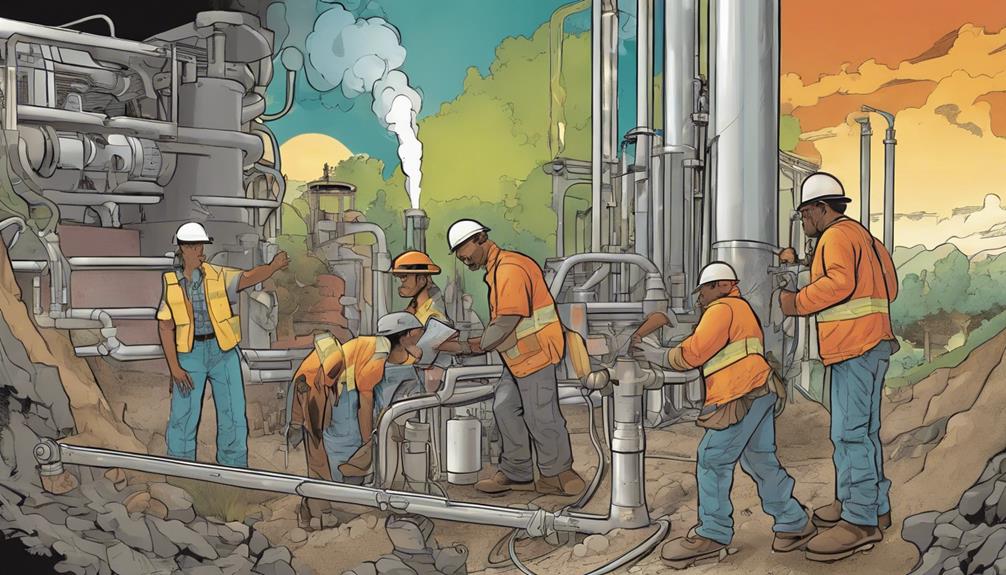
If you're considering sustainable energy options, geothermal energy has been gaining significant interest in recent years, especially in the United States. The United States is a leader in geothermal energy production, with states like California, Nevada, and Hawaii actively utilizing this renewable resource.
The interest in geothermal energy stems from its reliability, low operating costs, and minimal greenhouse gas emissions compared to traditional fossil fuels. The consistent nature of geothermal power makes it a valuable energy source, providing a stable electricity supply even when the sun isn't shining or the wind isn't blowing.
Moreover, the growing interest in geothermal energy is also fueled by its potential to reduce dependency on non-renewable energy sources and mitigate climate change. As more research and technological advancements are made in the field of geothermal energy, it continues to attract attention as a viable solution for sustainable power generation in the United States and beyond.
Frequently Asked Questions
Which of the Following Is Not True Regarding Geothermal Energy?
When it comes to geothermal energy, distinguishing what's accurate is crucial. Remember, not all statements about geothermal energy are true. Be critical and make sure you're well-informed to make informed decisions.
Which Is Not True About Geothermal Energy Quizlet?
Geothermal energy is a reliable renewable resource from the Earth's heat. It's essential to understand geothermal benefits and challenges for sustainable energy development. Land subsidence and gas emissions can be environmental hazards in geothermal production.
Which of the Following Is True for Geothermal Energy?
Embracing geothermal energy means tapping into Earth's natural heat for power, offering reliability and low environmental impact. You'll find consistent energy output, reduced greenhouse gas emissions, but also face initial costs and location constraints for best operation.
Which of the Following Facts About Geothermal Energy Are True?
Geothermal energy is renewable and reliable, reducing emissions and fossil fuel reliance. Specific locations are needed for power plants due to underground heat sources. Considerations include induced seismicity and water usage.
How Does the Lack of Geothermal Energy Impact the Environment and Economy?
The impact of geothermal energy can be significant on both the environment and the economy. Without utilizing this renewable energy source, there is an increased reliance on fossil fuels, leading to more pollution and greenhouse gas emissions. This can contribute to climate change and environmental degradation, while also leading to higher energy costs and economic instability.
Conclusion
So, now that you know the truth about geothermal energy, isn't it time to reconsider its potential as a sustainable source of power?
Don't let misconceptions hold you back from exploring the benefits of this renewable energy option.
With expert insights and facts debunking common myths, geothermal energy is a promising solution for a cleaner, greener future.
Why not take the next step in embracing this eco-friendly technology?

